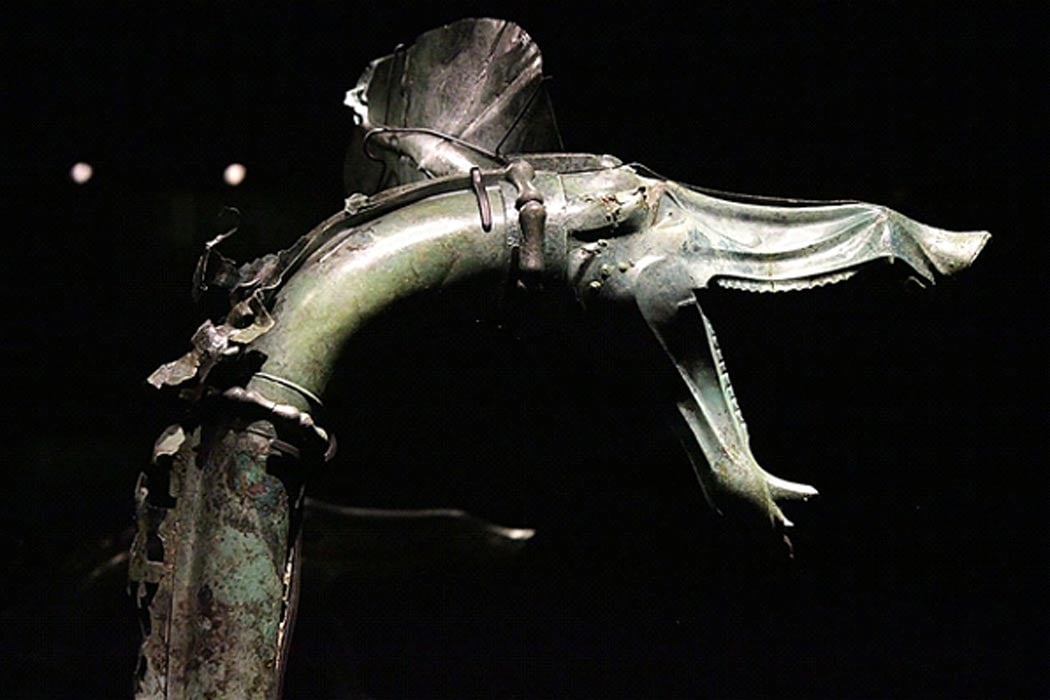The Carnyx: Ancient Trumpet Leading Celtic Warriors to Battle
The carnyx is an ancient musical instrument that best-known to have been used by the Celts during the Iron Age. Between 300 BC and 200 AD, the carnyx was used in many parts of Europe. In the ancient literary records, the carnyx is most commonly depicted as an instrument that accompanied Celtic warriors when they went into battle. Apart from literary sources, references to the carnyx have also been found on pieces of art and coins. Lastly, remains of this musical instrument have occasionally been found during archaeological excavations.
Carnyx Instrument
The carnyx may be described as a type of war trumpet. This instrument was a valveless horn that was made of beaten bronze, and can be easily recognized due to its ſ-shape. Another distinct feature of the carnyx is its bell, which often depicts the head of some animal. Such animals include boars, dragons, serpents, birds and wolves. The bells of the carnyx were fashioned after these animals so as to strike fear into enemy warriors. Additionally, some bells were made with joints at the jaws, which would cause the animal’s head to move when the instrument was blown, thus adding to the psychological effect it had on the enemy.
- 5,000-year-old musical scene found on pottery in Israel may reflect sacred marriage ritual
- Researchers chart thousands of miracle stories recorded about saints of the British Isles
Whilst the sight of the carnyx struck fear into the hearts of the enemy, it was the sound of it, which has been described as lugubrious and harsh, that probably had a greater impact on enemy morale. It may be pointed out that it is unlikely that we will ever know how their carnyces had sounded. Nevertheless, it is possible to recreate this instrument, given that some of them have been found during archaeological excavations, and perhaps achieve a slightly better understanding of how this instrument worked.

Three carnyx players are depicted at right on plate E of the Gundestrup cauldron. (Public Domain)
Deskford Carnyx
One example of a carnyx that has survived is the Deskford Carnyx, which was discovered in Deskford in Banffshire, Scotland. Only the head of this instrument was found, and it has been speculated that it had been buried as a votive offering to the gods. Although this instrument did not survive in its entirety, it provided enough information for a replica to be made. In order to recreate the rest of the carnyx, parallels, most notably artistic depictions from elsewhere in Europe were consulted. As a result, it is possible for us to hear the kind of sound a carnyx may have emitted when it was played.
- Ancient Irish Musical History Found in Modern India
- Ritual and Burial: The Strange and Elaborate Ways Humans Prepared Animals for the Afterlife
Nevertheless, the Deskford Carnyx is only one example of such an instrument. Prior to 2004, the remains of only five carynces were known. These instruments were found in Scotland, France, Germany, Switzerland and Romania respectively.

The Leichestown Deskford carnyx & reconstruction, Museum of Scotland (CC BY-SA 3.0)
In November 2004, a deposit of seven carynces was unearthed at Tintignac, a Gallo-Roman site at Tintignac in the Corrèze region of southern France. One of these carnyces had a bell in the shape of a serpent’s head with huge ears. A recreation of this carnyx was also made, and the sound produced by this instrument was quite different from that of the Deskford Carnyx. Thus, it has been shown that there were different types of carnyces in existence.
Recording of a reconstruction of the Deskford carnyx.
Carnyx from Tintignac
Additionally, the carnyx from Tintignac also forced experts to re-evaluate the way that this instrument was played. Prior to its discovery, it was thought that the carnyx was held vertically, as depicted in some pieces of ancient art. The carnyx from Tintignac, however, had a completely straight tube, as opposed to other carnyces which had a slight bend at the mouth end of the tube.

Carnyx of Tintignac, discovered in Corrèze, France. (CC BY-SA 3.0)
This meant that the carnyx from Tintignac was most likely played more or less horizontally, rather than vertically. This has led to the speculation that the carnyx, though traditionally associated with warfare, may have had a ritualistic function, and had been used for other occasions, such as feasts, funerals and weddings, as well.
Featured image: Carnyx from the recently discovered Tintignac group. Photo source: (CC BY-SA 3.0)
By Wu Mingren
References
Citizendium, 2013. Ancient Celtic music. [Online]
Available at: http://en.citizendium.org/wiki/Ancient_Celtic_music
de Pas, A., 2012. Send for the bard! Carnyx discovery leaves archaeologists little the wiser. [Online]
Available at: https://www.theguardian.com/science/2012/dec/11/france-gaul-carnyx-instrument-find
Education Scotland, 2016. Carnyx. [Online]
Available at: http://www.educationscotland.gov.uk/scotlandshistory/caledonianspictsromans/carnyx/index.asp
EMAP - European Music Archaeology Project, 2015. The Carnyx from Tintignac. [Online]
Available at: http://www.emaproject.eu/content/instruments/the-carnyx-from-tintignac.html
National Museums Scotland, 2016. Deskford carnyx. [Online]
Available at: http://www.nms.ac.uk/explore/stories/scottish-history-and-archaeology/deskford-carnyx/

















